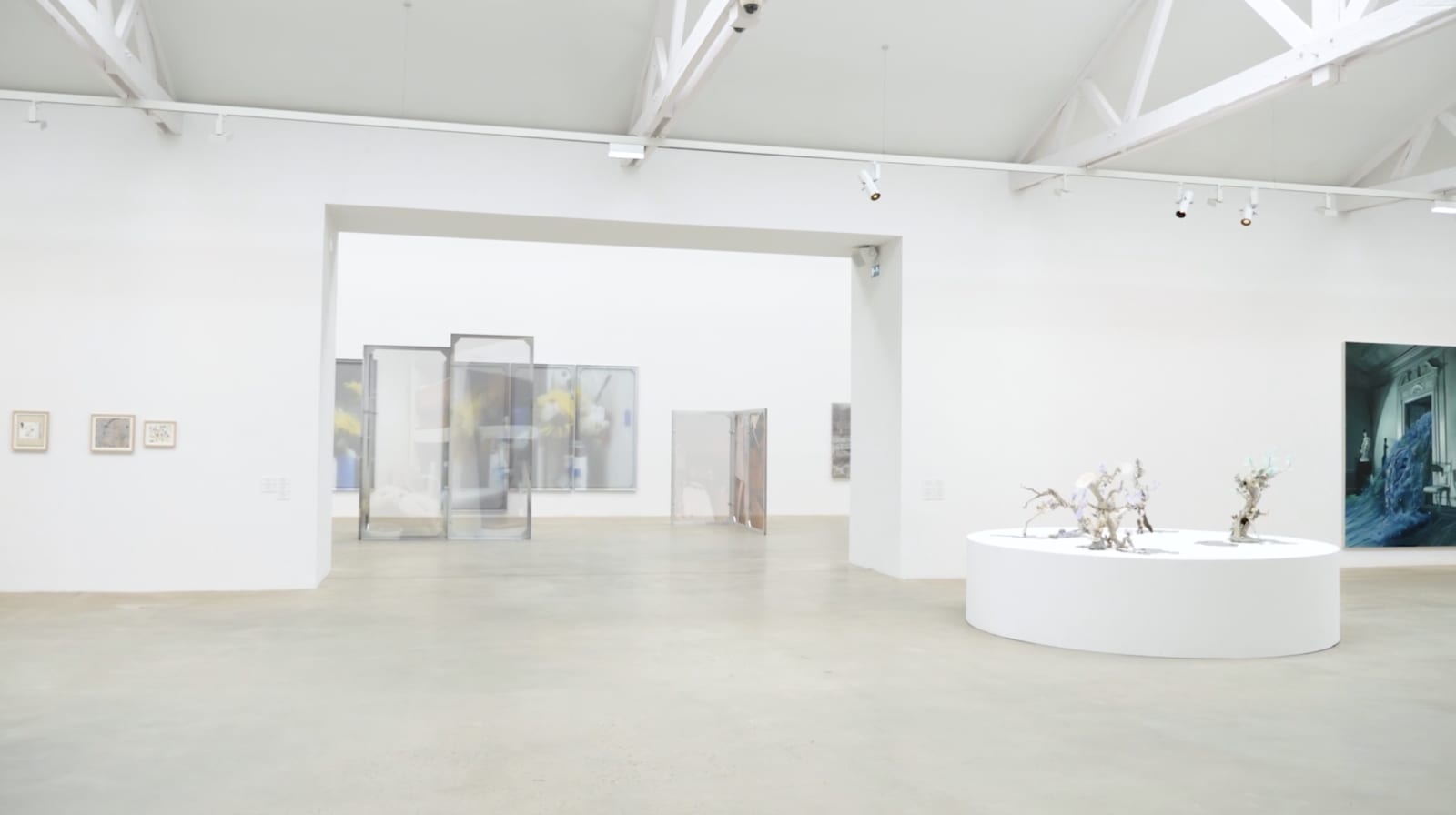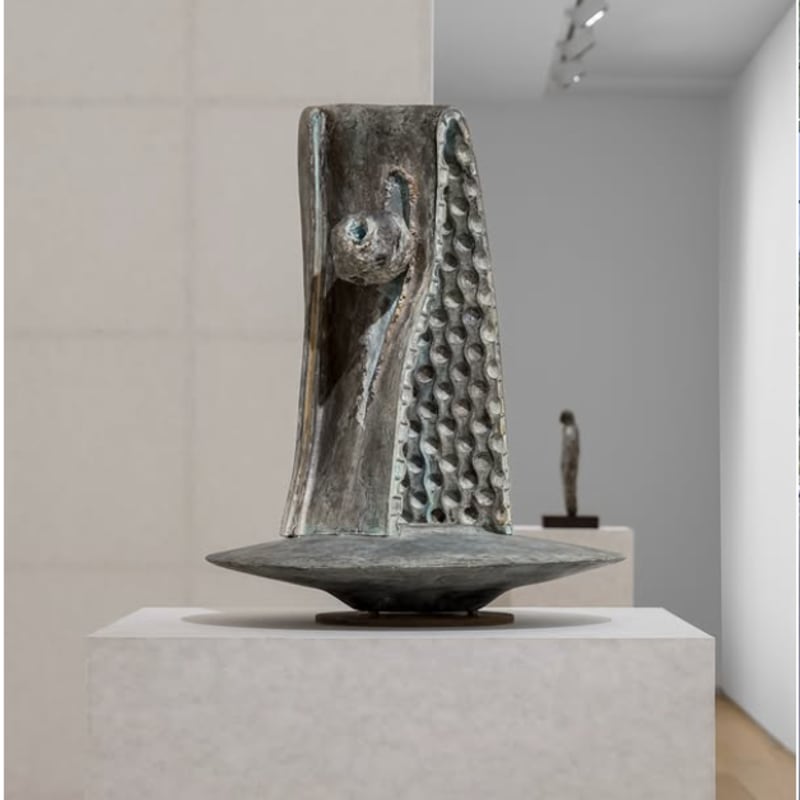Re-enchantment
It’s interesting to see how, in the 21st century, artists are more and more conscious of the consequences of the past century, and notably hyper-rationalisation and the growing ecological crisis, and are trying to change their approach to painting and to making through collaboration: by collaborating with nature, with the non-human and by localising the history and symbolism of each material. — Oona Doyle, curator
Artist duo Dorota Gawęda (b. 1986, Lublin, Poland – lives in Basel) & Eglė Kulbokaitė (b. 1987, Kaunas, Lithuania – lives in Basel) weaves together ecology and technology, science and magic, nonhuman intelligence and sensorial experience. The exhibition presents a mirage-like installation that features chimerical flowers.
Enchantment means falling under the spell of magical influences, while re-enchantment implies an act of repairing through wonder. Some of the artists in the exhibition invert the hierarchy between landscape and figure, and others merge human figures with the animal, mineral and plant realms, countering an anthropocentric view and blurring the boundaries between human and non-human. Other artists collaborate with living matter rather than instrumentalising it, giving free rein to the transformative power of materials, which evolve over the course of the exhibition. By moving away from a linear perspective and favouring multidimensional viewpoints, the artists strive to reinvent our relationship with the reality that surrounds us.

In works by Teresa Pągowska (1926–2007, Warsaw, Poland), dream space is layered onto reality, softening the boundaries between the two dimensions. Known for her inventive and felt treatment of the female figure, she draws on women’s experience of their surroundings, as well as her own dreams, which she materialises onto the canvas. Oona Doyle, the curator of the exhibition, sets forth: ‘In a society that prioritises men’s point of view, women’s experiences are often relegated to the background. In the face of this patriarchal system, imagination offers the possibility of liberating oneself from an imposed reality.’
Teresa PągowskaŚlady - wersja druga (Traces - second version), 2005
Acrylic, tempera on canvas
129.5 x 139.5 cm (50.98 x 54.92 in)

This dreamlike, sensory pictorial experience is echoed in the phantasmagorical paintings of Ariana Papademetropoulos (b. 1990, Los Angeles, USA – lives in LA), for whom ‘painting is a portal to another world’. In her canvases, human figures meet with natural forms, and the elements burst into domestic spaces, expressing a strong desire to connect with nature.
Ariana PapademetropoulosThe Organ of Magical action, 2024
Oil on canvas
233 x 274 x 4 cm (100 x 80.91 x 1.57 in)


I am inspired by the multitude of inner worlds and the sacred geometry we find when we look at plants or crystals under microscopes. If you are constantly in awe of nature, you feel the need to protect it. This got me remembering how we tend to protect what is visible unfortunately. So how does one honour the invisible energies and underline the interconnectivity of all things physical and non? — Bianca Bondi

These transformative creatures weave fragments of our material world into fables that become portals opening to otherworldly terrains. Myth-making, as a universal mechanism for connecting to the land and navigating environmental uncertainties, inspires this process of re-mythologizing and re-storying. It becomes a method to find a sense of belonging in foreign places I migrate to, and conjuring a sense of wonder in a demystified and damaged landscape. — Shuyi Cao
Shuyi CaoEvery name carries a deity (stone bloomer), 2023
rocks, minerals, driftwood, oyster and clam shells, seashell fragments, horseshoe crab, ceramic, glass, barnacles, weathered rubber, recycled plasetic, resin, metal, acrylic paint
50 x 56 x 81 cm (19.69 x 22.05 x 31.89 in)


Olga Grotova (b. 1986, Chelyabinsk, Russia – lives in London and Paris) makes all of her own paints, using pigments made from stones or from plants. She also collects soil, which she incorporates into her works, alongside the imprints of plants from the communal gardens of her grandmother and great-grandmother, who were condemned to forced agricultural labour during the Soviet era, alongside millions of other women. By experimenting with materials, and in light of transgenerational research, the artist uncovers the history of these invisibilised women.
Olga GrotovaSlovo, 2024
Photograms, haematite, pigments, on linen
230 x 180 x 4 cm (90.55 x 70.87 x 1.57 in)

The way I understand re-enchantment is in reconnecting to the world by means that maybe have been forgotten or something that is not taught in the history class. It's really reconnecting to your history, to the land, to your place in this system of coordinates that you're born to through your senses, through your body. — Olga Grotova

Mathieu’s landscapes reveal tears and wounds that allude to the horrors of the Duvalier dictatorship in Haiti (1957–1986), while also communicating a vitality that pulsates on the surface of the canvas, suggesting the possibility of renewal. Several time-spaces coexist on the same canvas, revealing the extent to which history is lodged in matter.
Manuel MathieuL’éveil, 2020–2022
Acrylic, ink, dust, charcoal, chalk, tape, oil sticks
91.4 x 76.2 x 5 cm (35.98 x 30 x 1.97 in)

Wanda Mihuleac (b. 1946, Bucharest, Romania – lives in Paris) reminds us that ‘in the word re-enchantment we hear CHANT, to sing’. In her tautological poems, the artist writes words with the substance they are made of, disrupting the distinction between language and materiality. Poetry, but also storytelling and mythology, offer a different way of relating to the world and to accessing knowledge through metaphor and symbol.
Wanda MihuleacFeu, 1976-78
C-Print on Baryta Satin Paper /white lacquered maple frame
Image 29.3 x 40.8 cm (11.54 x 16.06 in)

The curatorial format allows a sensory journey through Wanda Mihuleac’s poems. In her photographs, she sculpts shadows, slit, water, earth, fire and reflection – words that resonate with the other works on view, linking the artists together. Works by Dorota Gawęda & Eglė Kulbokaitė, Olga Grotova and Bianca Bondi interact with the natural light, attempting to capture a process of enchantment.
































































































































































































